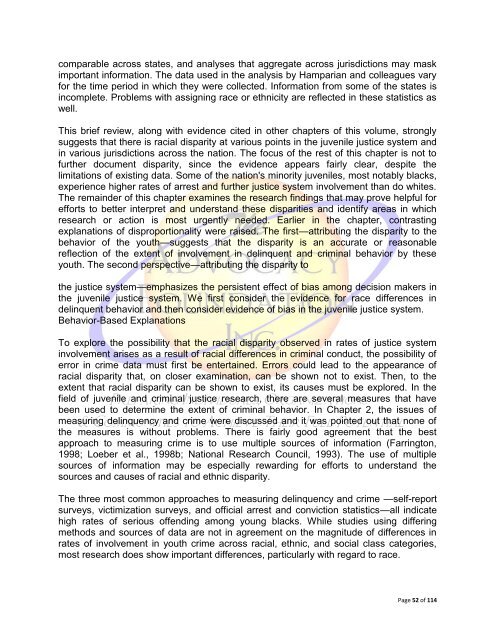African-American Youth in The Juvenile Justice System
African-American Youth in The Juvenile Justice System
African-American Youth in The Juvenile Justice System
Create successful ePaper yourself
Turn your PDF publications into a flip-book with our unique Google optimized e-Paper software.
comparable across states, and analyses that aggregate across jurisdictions may mask<br />
important <strong>in</strong>formation. <strong>The</strong> data used <strong>in</strong> the analysis by Hamparian and colleagues vary<br />
for the time period <strong>in</strong> which they were collected. Information from some of the states is<br />
<strong>in</strong>complete. Problems with assign<strong>in</strong>g race or ethnicity are reflected <strong>in</strong> these statistics as<br />
well.<br />
This brief review, along with evidence cited <strong>in</strong> other chapters of this volume, strongly<br />
suggests that there is racial disparity at various po<strong>in</strong>ts <strong>in</strong> the juvenile justice system and<br />
<strong>in</strong> various jurisdictions across the nation. <strong>The</strong> focus of the rest of this chapter is not to<br />
further document disparity, s<strong>in</strong>ce the evidence appears fairly clear, despite the<br />
limitations of exist<strong>in</strong>g data. Some of the nation's m<strong>in</strong>ority juveniles, most notably blacks,<br />
experience higher rates of arrest and further justice system <strong>in</strong>volvement than do whites.<br />
<strong>The</strong> rema<strong>in</strong>der of this chapter exam<strong>in</strong>es the research f<strong>in</strong>d<strong>in</strong>gs that may prove helpful for<br />
efforts to better <strong>in</strong>terpret and understand these disparities and identify areas <strong>in</strong> which<br />
research or action is most urgently needed. Earlier <strong>in</strong> the chapter, contrast<strong>in</strong>g<br />
explanations of disproportionality were raised. <strong>The</strong> first—attribut<strong>in</strong>g the disparity to the<br />
behavior of the youth—suggests that the disparity is an accurate or reasonable<br />
reflection of the extent of <strong>in</strong>volvement <strong>in</strong> del<strong>in</strong>quent and crim<strong>in</strong>al behavior by these<br />
youth. <strong>The</strong> second perspective—attribut<strong>in</strong>g the disparity to<br />
the justice system—emphasizes the persistent effect of bias among decision makers <strong>in</strong><br />
the juvenile justice system. We first consider the evidence for race differences <strong>in</strong><br />
del<strong>in</strong>quent behavior and then consider evidence of bias <strong>in</strong> the juvenile justice system.<br />
Behavior-Based Explanations<br />
To explore the possibility that the racial disparity observed <strong>in</strong> rates of justice system<br />
<strong>in</strong>volvement arises as a result of racial differences <strong>in</strong> crim<strong>in</strong>al conduct, the possibility of<br />
error <strong>in</strong> crime data must first be enterta<strong>in</strong>ed. Errors could lead to the appearance of<br />
racial disparity that, on closer exam<strong>in</strong>ation, can be shown not to exist. <strong>The</strong>n, to the<br />
extent that racial disparity can be shown to exist, its causes must be explored. In the<br />
field of juvenile and crim<strong>in</strong>al justice research, there are several measures that have<br />
been used to determ<strong>in</strong>e the extent of crim<strong>in</strong>al behavior. In Chapter 2, the issues of<br />
measur<strong>in</strong>g del<strong>in</strong>quency and crime were discussed and it was po<strong>in</strong>ted out that none of<br />
the measures is without problems. <strong>The</strong>re is fairly good agreement that the best<br />
approach to measur<strong>in</strong>g crime is to use multiple sources of <strong>in</strong>formation (Farr<strong>in</strong>gton,<br />
1998; Loeber et al., 1998b; National Research Council, 1993). <strong>The</strong> use of multiple<br />
sources of <strong>in</strong>formation may be especially reward<strong>in</strong>g for efforts to understand the<br />
sources and causes of racial and ethnic disparity.<br />
<strong>The</strong> three most common approaches to measur<strong>in</strong>g del<strong>in</strong>quency and crime —self-report<br />
surveys, victimization surveys, and official arrest and conviction statistics—all <strong>in</strong>dicate<br />
high rates of serious offend<strong>in</strong>g among young blacks. While studies us<strong>in</strong>g differ<strong>in</strong>g<br />
methods and sources of data are not <strong>in</strong> agreement on the magnitude of differences <strong>in</strong><br />
rates of <strong>in</strong>volvement <strong>in</strong> youth crime across racial, ethnic, and social class categories,<br />
most research does show important differences, particularly with regard to race.<br />
Page 52 of 114

















